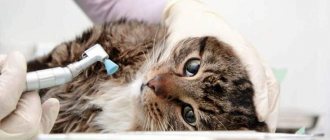14328Administration
1
Many people do not want to have cats because of their tendency to mark all vertical objects in an apartment or house, so the choice often falls on cats. Male felines do this quite regularly, especially after puberty. However, it is difficult to answer unequivocally whether cats mark territory like cats.
In most cases, the owner simply confuses banal urination with a mark. Cats sit down to go to the toilet. When marking objects, they stand with their backs to the surface and raise their tail, releasing a few drops of liquid.
When concerns are confirmed, it is important to know what to do if your cat is marking its territory. The process of castration and sterilization is very stressful for animals and this procedure does not always help.
The main reason for marking is a change of environment, heat, a new family member or animal. The cat reacts to stimuli instinctively, so you should not shout at it. Radical actions generally only make things worse.
How can a cat mark territory?
Cats that want to mark things perform the following algorithm of actions:
- fits a vertical surface;
- straightens up and raises its tail, shaking it a little;
- excretes a little urine horizontally.
Sometimes when an animal marks objects, the posture may differ slightly. The main similarity is the extremely small amount of fluid released. Usually it is no more than 1 ml.
To mark territory, cats often rub their faces against certain objects. Many owners think that their pet lacks affection, but in reality everything is much simpler. On the face of cats, near the eyes, there are special glands that produce a strong odor. A person does not feel it, but other animals immediately understand that the place is already occupied.
© shutterstock
You can often notice that cats sniff each other's anus when they meet. The anal glands, which secrete an odorous secretion, are located in this place. Raising its tail, the pet seeks to show its scent. You can notice this if you stroke it along the back. At the same time, the cat will begin to protrude the back of its body.
Cats wash themselves not only to maintain cleanliness, but also to distribute secretions throughout the body.
For example, by licking the genitals, they spread the smell from the anal glands along the back of the body. The secret will be more clearly visible to other animals.
Representatives of the cat family have very small glands on their paws. When cats sharpen their nails, they mark objects. This leaves visual marks and a corresponding smell.
Cats can mark not only with the help of fluid secreted by the glands, but also with saliva .
However, it does not carry any information about the animal’s sexual behavior, for example, about the onset of estrus.
Smell and feel
In the world of cats, smells play a colossal role, providing them with a significant, if not the lion's share of information about the world around them. The cat's body is covered with special glands that synthesize and secrete pheromones - a mixture of several low-molecular odorous substances. These glands are in close proximity to the sweat and sebaceous glands, the urinary tract and the anus, so almost any animal secretion serves as a pheromone mark. These marks tell other cats whether the animal is familiar or unfamiliar, healthy or unhealthy, male or female, and influence many important behaviors, including aggression, maternal behavior, courtship, and mating. In addition to cat pheromones, the world is full of ordinary, but no less interesting aromas: mice, birds, dogs, people, catnip, valerian and many other objects smell.
To perceive and analyze all this scent writing, a developed olfactory organ is needed. Cats have two of them (Fig. 1). First of all, this is the usual sense of smell, functioning simultaneously with breathing. About a third of the air inhaled through the nostrils passes from the nasal cavity to the olfactory mucosa. There are receptors of the olfactory epithelium, covered with mucus, which protects the epithelium from direct contact with air. Mucus is produced by Bowman's glands, interspersed between the olfactory cells. After passing through the mucus layer, the volatile molecules reach the olfactory receptors. From them, signals are sent to the olfactory bulbs and other areas of the brain that form the olfactory lobe. In this way, cats sense and distinguish odors. However, in order to perceive the information that pheromones contain, another structure is needed - the vomeronasal organ (VNO). We have written about it, as well as about pheromones, more than once, see, for example, “Chemistry and Life” No. 7, 2015.
Rice. 1.
A cat has two senses of smell
The VNO is a paired organ located in the palatine part, in small depressions on the sides of the nasal septum. It consists of two closed elastic tubes filled with liquid and connected through the nasopalatine canal to the oral and nasal cavities. Inside the tubes there are receptors and mucous glands. Receptors interact with molecules that enter the VNO along with fluid from the oral cavity. Mucus contains proteins that have an affinity for pheromone molecules, that is, they help capture them. The stimuli caused by pheromones are transmitted along the vomeronasal nerve to the olfactory bulbs, amygdala and hypothalamus. Unlike the normal olfactory system, the VNO is not connected to the cerebral cortex.
Rice. 2.
Flehmen is a grimace of perception of pheromones. The mouth is open, the upper lip is raised, the tongue moves. Photo: flickr.com / Malingering
It has one more fundamental difference: while the sense of smell is combined with breathing, the VNO is inaccessible during normal breathing. In order for pheromones to reach the corresponding receptors, it must be specially opened. To do this, cats, like other mammals with VNO, form their lips into a grimace called flehmen: the upper lip rises, the mouth is slightly open, the tongue moves (Fig. 2). Raising the upper lip causes contraction of the smooth muscles that open the VNO ducts. The expansion of the ducts creates a pressure difference, the liquid carrying pheromones is absorbed from the oral cavity into the lumen of the VNO, and signaling molecules are physically able to contact the receptors. After some time, the diameter of the tubes decreases, mucus with pheromones is removed from them into the oral cavity, the organ is washed and is ready to taste a new portion of information.
How do animals know that the VNO needs to be opened? Perhaps by the smell of pheromones that they smell through their nose. Since flemen is also common in castrated animals, we can conclude that it is caused by any pheromones, not just sex pheromones.
The VNO also perceives ordinary odors, for which three types of receptors are used: V1R, V2R and FPR. In domestic cats, only V1R has been studied. There are several variants of them, and, according to one hypothesis, the more of them, the better the animal distinguishes odors. A tiger, for example, has 21 receptor variants, while a domestic cat has 30. Of course, they are far from rats with 120 V1R types, but they are significantly superior to dogs, which have only 9 variants. Two feline olfactory researchers at Oregon State University, Kristin Vitale Shreve and Monica Udell, suggest using cats to detect drugs or explosives and people under rubble, or to detect cancer or tuberculosis by scent ( Applied Animal Behavior Science
, 2021, 187, 69–76). If dogs with their nine V1R types are capable of this, then cats are even more capable! Researchers believe that cats, due to their flexibility, lightness, small size and ability to balance, will cope even better than dogs with searching for people. True, cats have a reputation for being difficult to train, but Christine Shreve assures that they can be taught a lot if you get it right, and even opened a school at the university for kittens and their owners. It seems she had never heard of Yuri Kuklachev. The researcher does not disclose the method of training service cats. Perhaps her project is just a tactical move to obtain a research grant.
Why do cats mark objects in the house?
Cats begin to mark their territory due to the influence of various irritating factors. Unlike cats, they do this much less often, so the owner may confuse the marking process with urination. The list of main reasons is as follows:
- During illness, the pet can relieve itself outside the tray. The problem arises mainly due to the formation of kidney stones and the development of cystitis. The animal, on a subconscious level, gets the impression that the pain is manifested precisely because of the tray, so it looks for other places of fusion of need. The situation can be corrected, but to do this, the pet must be shown to a veterinarian. Otherwise, the disease will progress.
- Representatives of the cat family may mark their territory due to the arrival of a new person or another animal in the house. The pet will perceive such an update as a threat to its territory. The main instinct will advise him to mark objects, showing who is in charge in the house. If the problem is the arrival of a new family member, then only time will help. The cat must get used to the person in order to “accept” him. When getting another pet, you need to be prepared to share the house between them. Otherwise, there will be little chance of avoiding conflict.
- Sometimes a pet begins to mark objects as a result of another animal marking the front door. The owner will have to get rid of the foreign smell and try to prevent the situation from recurring.
- There have been cases when a cat began to mark corners in the house after moving . For her, the new environment has not yet been explored, so instincts are triggered. Over time, everything returns to normal.
- After sterilization, the cat marks in the apartment due to the stress it has experienced. There is no need to scold her, since time must pass for the animal’s psyche to recover. In severe cases, you may want to consult with your veterinarian about giving a sedative medication to calm your pet's nervous system.
- A cat may mark its territory due to raging hormones. After reaching 7-8 months, it becomes a sexually mature individual. If a cat lives in the neighborhood, the female begins to mark the corners of the house, showing the boundaries of her possessions. The whole problem here is the activation of instincts, since against the backdrop of hormonal surges there is a fear of losing territory. Sterilization does not actually help in this situation. The animal returns to normal and continues to mark. The only salvation will be to get rid of the potential sexual partner, at least for the duration of the heat.
- There are situations when a cat has to be left with strangers. She begins to mark her territory as a sign of protest or simply due to stress. The animal’s behavior returns to normal only after returning to its familiar environment.
© shutterstock
Do cats mark territory like cats?
9998Madmin 1
Many people do not want to have cats because of their tendency to mark all vertical objects in an apartment or house, so the choice often falls on cats. Male felines do this quite regularly, especially after puberty. However, it is difficult to answer unequivocally whether cats mark territory like cats.
In most cases, the owner simply confuses banal urination with a mark. Cats sit down to go to the toilet. When marking objects, they stand with their backs to the surface and raise their tail, releasing a few drops of liquid.
When concerns are confirmed, it is important to know what to do if your cat is marking its territory. The process of castration and sterilization is very stressful for animals and this procedure does not always help.
The main reason for marking is a change of environment, heat, a new family member or animal. The cat reacts to stimuli instinctively, so you should not shout at it. Radical actions generally only make things worse.
Processing marked places
To wean your dog from marking on pieces of furniture in the apartment, corners and other favorite places, it is necessary to treat soiled surfaces.
Industrial products
In pet stores you can buy products that will help get rid of the corrosive smell of dog urine and
will prevent the appearance of new marks. Among them:
- Liquidator;
- Smart spray;
- Fresh;
- Eco life powder for marks and urine odor.
You can try household chemicals with chlorine. This will get rid of the smell of urine, but will not prevent the dog from dirtying his favorite place again.
Home Remedies
If the dog begins to mark in the apartment, you can use a folk remedy that gets rid of the smell of urine. In addition, this will not allow the animal to return to the “scene of the crime” to continue what was started. You will need vinegar, hydrogen peroxide and soda.
- First you need to thoroughly dry the area using porous paper or an absorbent diaper.
- Moisten the treated area generously with vinegar and water solution. To do this, take 1 part vinegar and 3 parts water. To prevent the liquid from spreading beyond the required diameter, cover the top with a paper napkin or towel. You must wait until the surface is completely dry.
- Sprinkle regular baking soda on the area stained with urine.
- Mix 100 grams of hydrogen peroxide with 1 teaspoon of liquid detergent and add 100 grams of water. Mix thoroughly. Using a spray bottle, generously spray the surface sprinkled with soda.
- Leave for 3 hours. Then carefully remove the residue with a washing vacuum cleaner or a damp cloth.
This method is convenient because it does not require large expenses. The chemical processes occurring during treatment will rid the marked area of odor. This method can wean the dog from marking objects in the apartment.
To discourage a male dog from tagging, you will need to be calm and patient. Screaming and a rude attitude will not achieve success in parenting. An even, friendly attitude towards your pet promotes mutual understanding and quick weaning from a bad habit.
How to wean a dog from marking
The sexual instinct is one of the strongest in dogs of reproductive age (over 10 months). It influences the behavior of individuals of both sexes.
Castration
This is an effective way to wean both the bitch and the dog from marking in the apartment. If you castrate your pet (remove the reproductive organs), the problem with marks in the house will disappear. The animal will no longer try to attract an individual of the opposite sex.
This method is used if there is no need to obtain offspring. When breeding the breed, castration is not used. In this case, you need to find a mate for your pet. After mating, the adult dog becomes calmer.
Physical punishment
Slapping, hitting and screaming will not help if the animal has a desire to leave a mark in the corner. This behavior of the owner will only embitter the pet. The animal will begin to leave marks in the absence of the breadwinner, often out of spite.
Walk
What to do if castration is not a solution, but it is recommended to avoid physical punishment?
In this case, experts advise increasing the duration of walks (at least 1 hour 2 times a day). If possible, they also add daily exercise. During the walking process, it is worth engaging the animal, running with it, playing, throwing a stick. Active games exhaust the animal; after a walk, the pet will simply want to relax, and not mischief in every corner.
Drinker and feeder
These items will help stop your dog from peeing in every corner. The bowl from which the animal eats and drinks is placed where it is accustomed to relieve itself in the house. Dogs don't mark where they eat. The method will help get rid of foul-smelling puddles.
Space limitation
You can temporarily limit the animal’s access to those places in the apartment where he liked to defecate. Corners can be fenced off with furniture.
In the absence of the owner or at night, small dogs are sent to large spacious boxes, large pets are left in improvised pens.
The fence can be made of plywood, metal sheet or rods.
Hygiene
The dog’s favorite places in the house, which she has chosen to relieve herself, are carefully treated each time with a detergent containing chlorine. The substance is used with caution, in a diluted state, as it can harm the dog’s sense of smell. After treatment, the animal is not allowed near the cleaned area.
Oils or bulk substances that do not appeal to the dog’s keen sense of smell are helpful. They have a strong aroma that repels the animal.
So, what smell do dogs hate:
oil of any citrus: lemon, orange, grapefruit;- ground red pepper;
- tobacco.
The dog cannot tolerate the aromas of these plants, and he will no longer appear in the areas where they are applied.
Contact
In some situations, the dog marks to spite the owner. Often this happens after an undeserved spanking or shouting. The animal remembers the insult inflicted and takes revenge for it.
In this case, the owner should pay attention to his pet, talk to him, caress him, and treat him with a treat. Everything must be done to show that there is no aggression and the person’s behavior is friendly .
Eliminating bad habits
Having found out why a dog marks at home, you can begin to eliminate the causes and correct behavior. The main thing that should be done first is to review your diet and walking regimen. It is necessary to walk your pet after each feeding. This will make it easier to wean your dog from marking territory.
On the street
To wean your dog from marking on the street, you need to carefully observe your pet's behavior. At the beginning of the walk, the dog does its “business” quite quickly, without particularly looking for a place.
After 10-15 minutes, he takes a long time and deliberately searches for a place, sniffs and studies for a long time in order to settle down and mark the territory with his scent. This is where you need to distract your pet with a treat, a toy, or demand the execution of some command. It is necessary in any way to direct the actions of your four-legged friend away from the object of attention.
In the apartment
You can stop your dog from marking in your apartment in the following ways:
- Dogs do not mark the area where they eat. You should try placing bowls of food or drink near the area that your dog likes to mark most.
- The dog has a favorite place where he constantly marks. In this case, you need to try to get rid of the pungent odor. The smell of citrus fruits and tobacco repels dogs well. You can make a mixture of finely grated grapefruit peel and 100 grams of alcohol (or 200 grams of vodka). Mix everything together and let it brew for a week in a dark place. Apply the resulting liquid to the problem area.
- You can wean your dog from marking corners in the apartment during sexual activity using means that correct the pet’s behavior: “4 tails”, “Sex barrier”. But before using them, consultation with a veterinarian is required.
- If a male dog is not intended for breeding, then castration will help eradicate the habit of marking territory. During this manipulation, the testes are surgically removed. It sometimes happens that even after surgery the dog continues to mark. After 2-4 months, the hormonal levels fade away and the habit disappears. The most reliable way to sterilize a dog. The animal loses its sense of superiority and sexual desire, so there is no need to mark.
- Often a male dog marks if he is physically active, but has nowhere to put his energy. Regular walks using Frisbee elements, morning and evening jogging will get rid of dirty tricks.
- If your dog marks at home, you can wear special pants, made yourself or purchased at a pet store. The liner used in these panties absorbs all the liquid. This will prevent the animal from marking its territory.
- Sometimes a male dog marks after a conflict with the owner. There is only one way out - to improve relationships. The owner must give the pet maximum attention, care, and communication.
- One of the techniques for weaning a male dog from marking at home is to use a spray bottle of water when he tries to lift his paw.
- Barrier method. It consists of keeping a pet in a small enclosure during the absence of a person. The dog will not mark the territory where it sleeps.
You cannot use physical force or rudeness in trying to wean your dog from marking corners in the apartment. The pet will become even more angry and begin to play dirty tricks more often.
In public places
When visiting exhibitions and other public events, the habit of an adult male dog to lift his paw in inappropriate places can ruin the mood of both the owner and those around him. It is not easy to train a dog to mark in unfamiliar places. The owner will require maximum attention.
At the first sign of a desire to leave traces of your presence, you should distract the dog with a treat or toy. Driving on a leash is mandatory. As soon as the male dog begins to carefully sniff the scene of the alleged “crime,” the pet is pulled back, thereby stopping unwanted actions. We should not forget about the reward method so that the animal knows that it will receive a reward for good behavior.
Often, while walking in the yard, the dog is ready to dirty every car, bench, and entrance door. In order not to enter into conflict with neighbors, because few people will like such actions of a dog, the owner must monitor the behavior of the animal and in every possible way prevent attempts to mark. You can try the following methods: pulling the animal back with a leash, a voice prohibiting signal, clapping your hand, or blowing a whistle.
Can cats mark their owners?
If an animal begins to rub its head against you and your legs, then this is how it marks you. Cats have special glands behind their ears that leave their scent on you. After this, you go from being an ownerless owner to becoming the property of the cat. By this smell she will recognize you everywhere and accept you as one of her own.
But not only her... Wherever you go now, you will spread this invisible aroma of her pheromones everywhere and all the other cats in the area will know about it. That you have already been “privatized” by someone.
And also, this can serve as a source of a kind of announcement for them that you have a cat or cat who is waiting for their prince or princess.
Will a cat mark after already having a bond with a cat?
After the cat tries himself at least once in the role of a “man,” he begins to mark his territory even more actively, even if he lives in an apartment.
At the same time, the smell intensifies so much that it is impossible to get used to its specific aroma. You know when someone comes in and says: it smells like a cat. There are some ways to get rid of the smell of cat urine.
Why does a neutered cat mark?
If the cat has already been with a cat, then after that it is useless to castrate him; he will continue to mark everywhere. An initially neutered cat may begin to mark after suffering stress. For example, if you took home another pet.
In this case, even their instincts are triggered and they begin to fight for territory and their individuality.
Now you know everything about why cats mark in apartments and on the street. And when the next time your pet comes up to rub its muzzle against you or circle around your legs, you will already know its real intentions











